Gear
Last weekend I took the Wilderness Warrior Weekend class from Greg Nichols, John Chambers, and Sua Sponte near Kirksville, Missouri. I’ll just say up front that this was a great class. It’s a combination of HRO-1 (Team Tactics) and HRO-3 (Rural Patrolling) with Chambers throwing in a bit of the DMR class and knife fighting thrown in for kicks. I’ve taken quite a few courses from John, and attended a medical course where Sua taught. This is actually my first time taking a class from Greg Nichols, though I had seen him in action at the SI submachine gun class a few years ago. All three of them are current or former soldiers with experience in small-unit tactics.
I brought a lot of kit to this class (one of the lessons I drew from this experience is that I need a better way to organize stuff in my car, I spent a lot of time digging around for stuff).
My main rifle for the class was my SBR lower with a new upper I’d recently finished putting together: 10.5″ barrel, Gemtech 556-LE suppressor, with a Lancer handguard extending forward over most of the can, topped off by a forward mounted Aimpoint Micro. Honestly, this isn’t necessarily the optimal weapon for this sort of thing (it’s really more of a CQB gun) but I wanted to put it through its paces. As a backup, I also brought along a 16″ AR. For the DMR portion of the class, I brought a JP Rifles upper on a lower that I’d put together. Unfortunately, the night before driving to Kirksville I was testing the elevation adjustment when the turret slipped, leaving me uncertain about my elevation (I hadn’t tightened the turret down enough when I zeroed it). So I wouldn’t be able to use it effectively unless we had an opportunity to zero. I also brought along my Savage .300 Win Mag just in case I had the chance to bang some steel at 300 yards. Rounding things out I brought an iron sighted Glock to carry during the exercises and, of course, my RMR Glock carry gun for “social purposes” enroute.
As far as support gear goes, for the patrolling portions of the class I brought my HSGI war belt, camelback and a Eagle Industries 3-day pack. I also brought my sniper pack (an Eberlestock Halftrack) loaded up with bipod, rangefinder, and the like. I brought my multicam and as advised in the course thread I treated it with Permethrin to keep off ticks and other insects.
The course description and thread emphasized bringing food that you could eat in the field, so I packed lots of jerky, crackers, and other snacks. I knew it was going to be hot and humid, so I also brought a ton of water for keeping hydrated.
The fellow hosting the class offered the option of bunking on-site (either setting up a tent or laying out a cot in his barn). I knew the instructors would be staying on-site, so I decided to take him up on this offer. So I brought my camping gear (tent, sleeping bag, etc). I also brought along a nice bottle of whiskey, my contribution to the libations I figured would be passed around after a long day of training. Most of the rest of the class took advantage of the on-site option as well; only two students stayed in a hotel.
Almost the entire class ran AR type rifles. We had one AK, and Greg ran a SIG 556 Patrol on the first day. Sua also brought out a .308 bolt gun for some of the long range stuff. Most rifles had some sort of red dot, but there were also quite a few with magnified optics (all had some sort of optic on them). War belts were the most common support gear, but there were a substantial minority of chest rigs. Almost everyone was running a camelback for hydration.
Thursday
I headed out midday on Thursday for the five and a half hour drive from Wichita to Kirksville. With a few stops that got me there about 7:30. Many of my fellow students were on site already and we sat around shooting the breeze before turning in for the night.
Friday
Thanks to some noisy whippoorwills I rolled out of bed fairly early the next morning. I put the time to use to get some breakfast and make sure my kit was squared away. Sua and Greg came out to demonstrate a bit of PT.
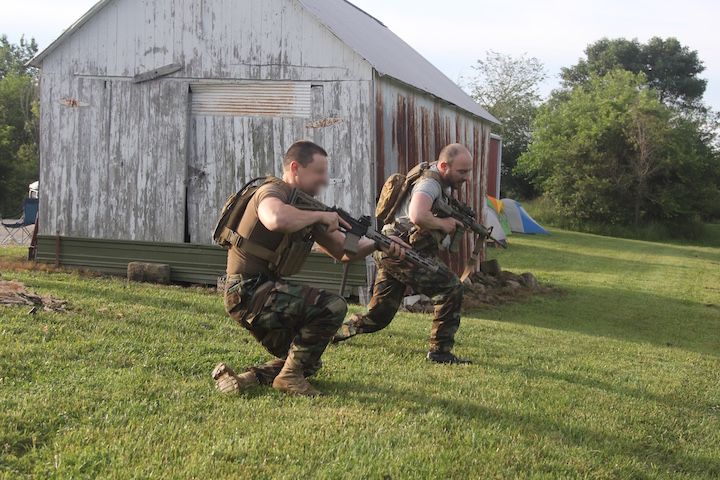

Today’s events would be held over at a second property, a nearby ranch that offered more distance for long range shooting and more flat ground for some team tactics drills. The ranch was only about ten miles away as the crow files, but as the saying goes, “you can’t get there from here”. The shortest path was a rather circuitous route down some back roads. Rather than having everyone navigate over there on their own we convoyed over with the host in the lead.
Once there, we passed around the waivers and everyone got geared up. Greg gave the safety brief, emphasizing that this was not a square range class and we needed trigger finger and muzzle discipline. John pointed out one student was using a chest rig with a concealment-type OWB holster/ He has very personal experience showing just how bad an idea that is, which he recounted to the group.
Sua followed this up with a medical brief. This covered the usual procedures for dealing with a gunshot wound or other traumatic injury. Given how rural the training area was, the decision was that if anyone was seriously injured we would throw them in a vehicle and take them to the hospital ourselves. Sua has a lot of experience dealing with traumatic injury, but he emphasized his desire not to have to do any medicine during this class.
There was also quite a bit of emphasis on heat issues. The high for Friday was in the 80s, and it was expected to top 90 the following day, with very high humidity. All three instructors emphasized the need to stay hydrated, both as part of the medical brief and throughout the class. Every time there was a pause in the action, “drink something”. Sua passed out a little pamphlet on signs of heatstroke. Everyone needed to monitor both themselves and their classmates for signs of heatstroke and dehydration.
He also talked about insects, particularly ticks. This is definitely tick country and tick borne diseases are no joke. Sua described Lyme disease as, “the gift that keeps on giving.” He emphasized the importance of self-checks and buddy checks for ticks. They release disease when they’re fill and they detach, so if you find and remove them, you’re good. Sua volunteered to put his sharp pointed tweezers to work pulling out ticks. Better not to get them in the first place though, hence the advice for pre-treating your clothes with Permethrin and bringing strong DEET.
We headed away from the vehicles and down into a field to get started with the training. One of the things that had been emphasized in the class thread was the need to set your gear up with the ability to sustain you away from your vehicle. This was not a class where you can walk back to the car every five minutes. Indeed, we were down in that field all day (a few folks made trips back to the car anyway, but by and large everyone rolled with what they carried down there).

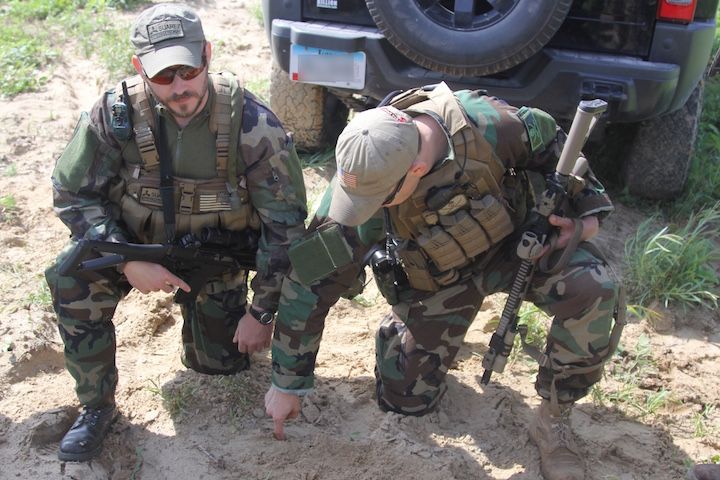
Greg started out with some lecture about different movement formations f0r a small team: file, wedge, and diamond. He talked through how to react to contact from the front, right, or left from each formation. They also went through various hand signals, both for switching between formations and other useful signals. During the discussion of the appropriate distance interval between team members he said something that really struck me. The standard answer is you need to be close enough to see your closest teammate based on the terrain and conditions (so in the jungle or at night you’ll be closer than an open field or during the day). However, there’s obviously a limit on this: even if you can make out your teammate 500 yards away across an open field that’s too big of an interval. Instead, stay close enough to see the guy’s fingers (important both as a general rule and for hand signals).

We broke up into three teams (two with four members and one with three) to work these drills dry, with each instructor (Greg, John, and Sua) taking one team. We went practiced the various formations, switching between them, calling them out and using hand signals.
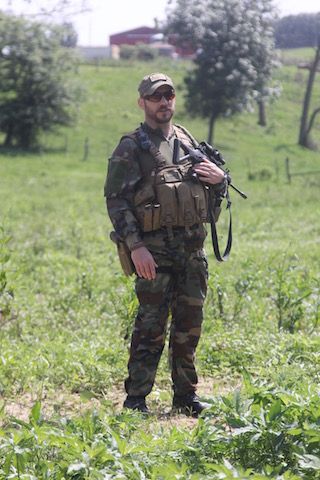
Once we had the formations themselves down we worked react to contact drills from the different directions and formations. The basic principle of react to contact is to get everyone on line and shooting at the enemy. Once everyone was up on the line, Greg integrated some bounding into the react to contact drills. Rather than the usual “moving”, “covering”, “set” verbiage for bounding Greg emphasized doing it more organically. If you hear at least two other guns going it’s OK to bound.
The class reassembled and we debriefed the drills. After setting up some targets against a good hillside backstop we ran the react to contact drills live, one squad at a time.
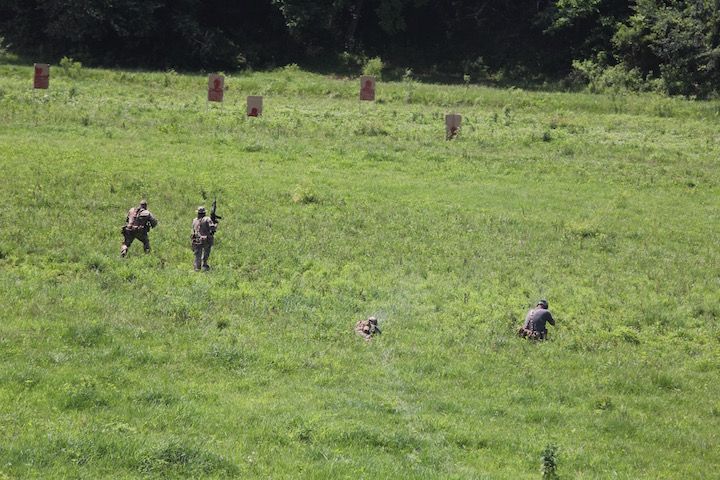

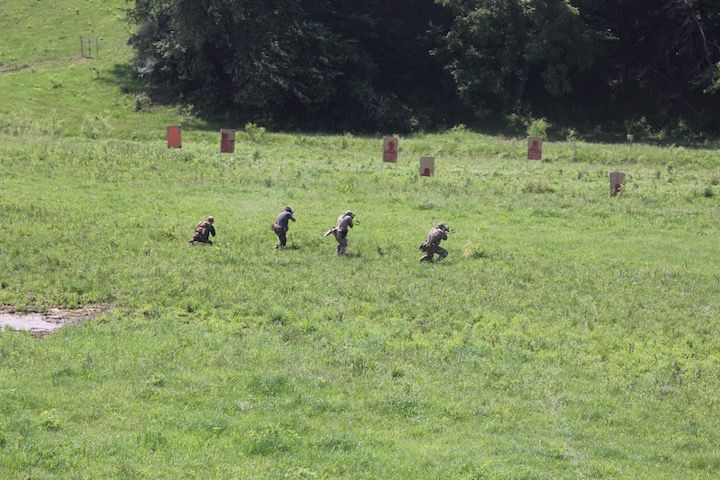
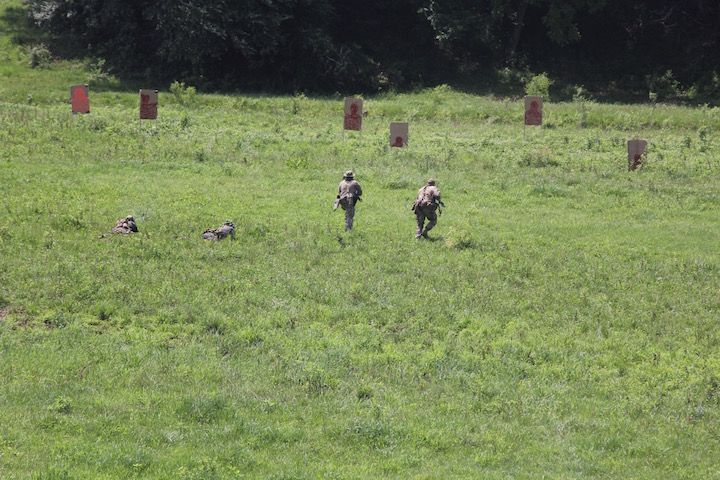

Once we’d rotated all the squads through the react to contact drills it was pretty hot to be running around and getting up and down bounding. Thankfully, Greg had taken account of this in setting the schedule and we switched from this bounding to doing some precision rifle work. This was what I brought my DMR for, but since I’d slipped the turret and it didn’t look like we’d have a chance to rezero, I just left it in the car and rolled with my suppressed SBR.
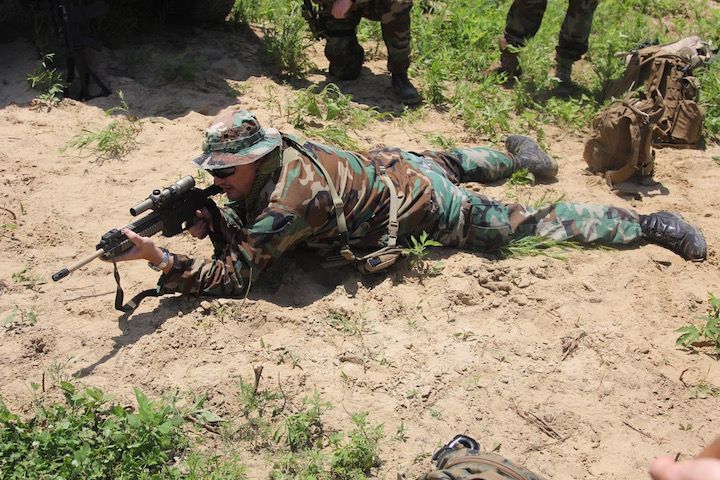
John Chambers took over for this segment, putting his former service as a Designated Marksman to use. He started out with a quick review of the fundamentals of marksmanship. They may not be high-speed low-drag, but they really are a requisite for precise shooting. John demonstrated how to build a solid prone position. He paired the students up and had them go do dry fire from prone. One student did the dry fire while the other worked his action so he could practice trigger reset and didn’t have to partially break down his shooting position between each shot.


Moving on, John demonstrated the sitting position. He covered both cross legged and open legged sitting, as well as another variation where you clutch the knees up to the chest and cradle the rifle crossways. After the demos, he sent the students out for another round of dry fire.
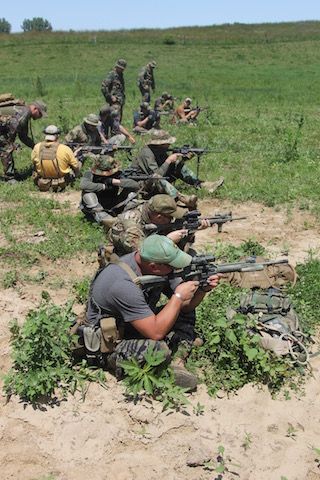
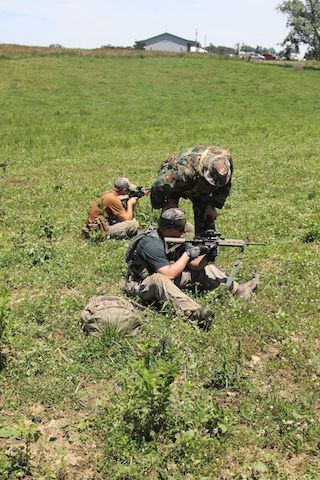
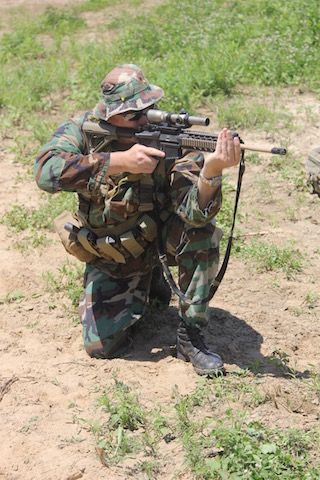
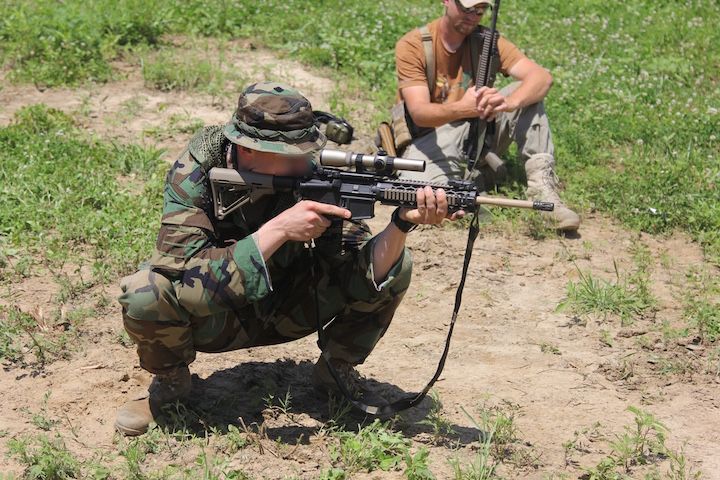
Next up was the kneeling position, which John demonstrated, but didn’t have the students go out and dry fire. Sua showed off Rice Paddy Prone (squatting) John also demonstrated both the traditional standing position and a couple of variations. One involved reversing the support hand, placing the fingers on the support side with the thumb pointed back towards the shooter forming a shelf for the rifle. The other involves reaching the support side hand back to the primary side bicep and cradling the rifle in the elbow. He had the students go out and try these with dry fire.
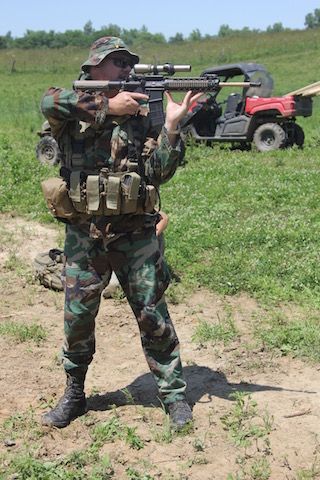



Having cycled through all the positions dry, the hosts set up some steel for us and we went live. Starting at 100 yards, John had everyone go through the prone, sitting, and standing positions, being sure to try some of the new variants they’d just learned.
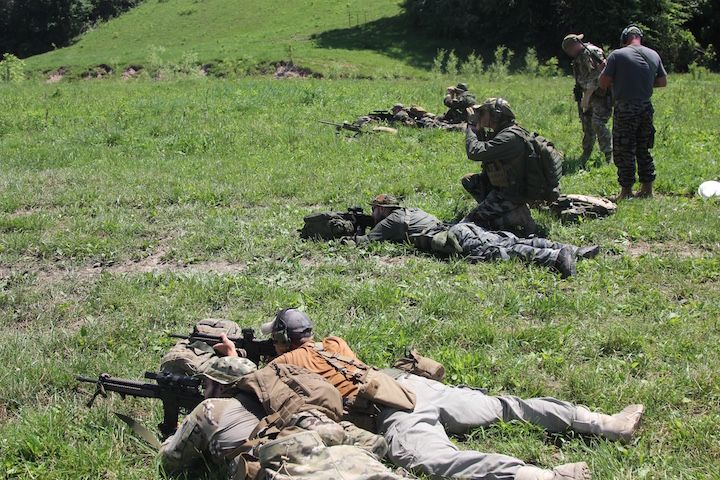


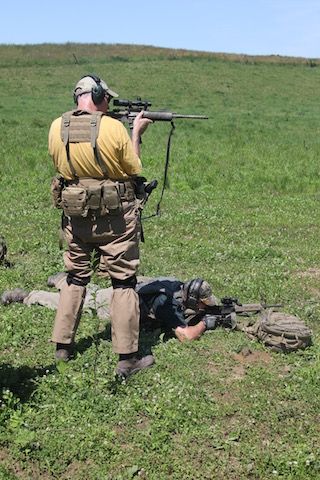
Moving back to 200 yards, we did the same thing. One of the students had some major trouble getting hits, eventually finding that the Aimpoint PRO was loose in his RS Regulate mount. He stripped it off and went to irons. One of the guys shooting an AR found that he was suddenly off a couple of feet, after being dead on at 100 yards. He had a free float forend, but his sling was attached to the sling mount on the front sight tower. When he put pressure on the sling when shooting, it disturbed the barrel enough for a major change in the point of impact.
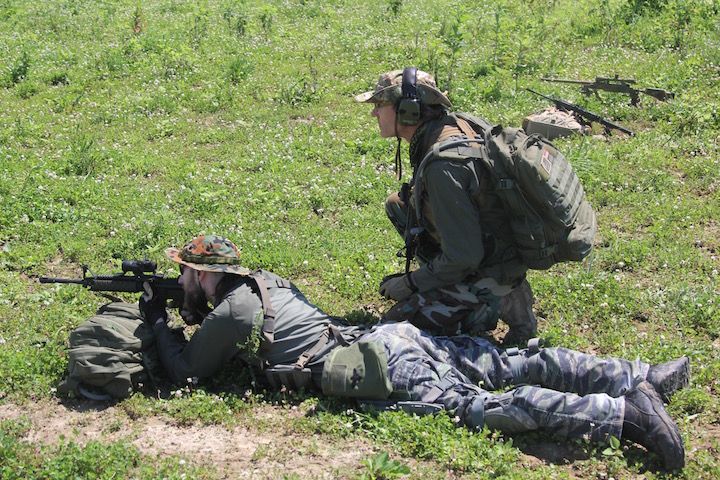
After finishing up at 200 yards we moved back almost all the way across the field and engaged some more distant targets (30″ manhole covers) at 457 yards. While everyone had pretty good success at the shorter distances, here the magnified optics clearly had the advantage. Just about everyone with a scope managed to hit consistently once they got the range. Red dots were a lot more hit or miss, though everyone got at least one hit (including the fellow with the now-iron sighted AK).
I think the long range portion of the class opened some eyes about potential of even a fairly normal AR’s long range accuracy in the right hands. It also served as quite an effective advertisement for the DMR course, and I think there was definitely some interest among the students in doing some more long range shooting.
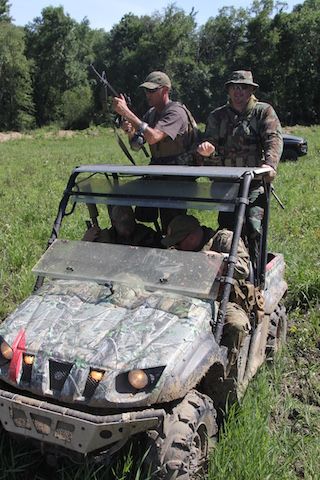
With this it was getting late in the day so we headed back to the vehicles and drove back to the other site.
The two hosts had volunteered to cook us dinner and they did not disappoint. They laid on a spread of steak, salad, cheesy potato casserole, grape salad, and deviled eggs. It was just the ticket after a long day in the field. Afterwords, we broke out the libations and spent a long evening in conversation and good fellowship among like-minded individuals.
Saturday
After the long day in the field the previous day, it was a bit easier to sleep in this morning, noisy birds or no. Still, I had plenty of time to eat some breakfast and get my gear ready for the day. Even after hosing myself down with spray sunblock the day before, I’d still gotten some sunburn on my nose, so I rubbed a bunch of sunblock on my nose, then sprayed my whole head.
Today we’d be training at the same property where we stayed the night, rather than driving off-site. We broke up into our teams, again each with one instructor, and each team headed out to a separate area. The house and barn are basically up on a ridge, with fingers of high ground reaching out from it. The rest of the property drops off very steeply into low gullies and creeks. The ridge and fingers are tall grass (mowed in the area around the house) as are some open lanes going down the slopes. The rest is covered in thick brush and small and medium sized trees. The elevation difference between the low ground and the high ground is only about 100 feet, but it is a very abrupt 100 feet.
Greg lead my team down one of the fingers to some low ground. On the way we practiced moving tactically, in both line and wedge formations. He also talked a bit about dealing with danger areas. At this point we were moving through the open grassy areas along the fingers, which would be really dangerous for such a small unit. In reality you’d want to move through the more brushy, wooded areas on either side. However, that not only requires a lot more time and effort, it also makes more demands on the tactical movement skills we were still learning.
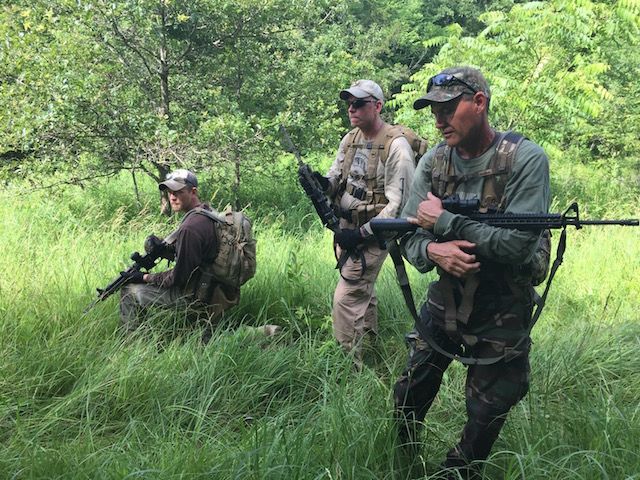
Once we were down in the bottomlands Greg talked about individual camouflage. Faces are one of the most instantly recognizable features of the human body, so he covered the fundamentals of camouflaging your face and demoed on himself before passing around a cammo facepaint compact so that we could all get our faces covered.
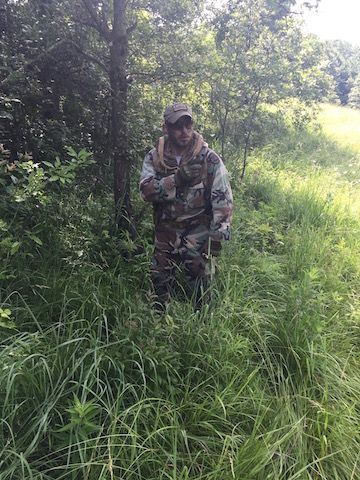
The other instantly recognizable feature is the outline of the human body. He talked about ways to break that up using a veil or shemagh, or by applying some vegetation to your hat (boonies are particularly good for this).
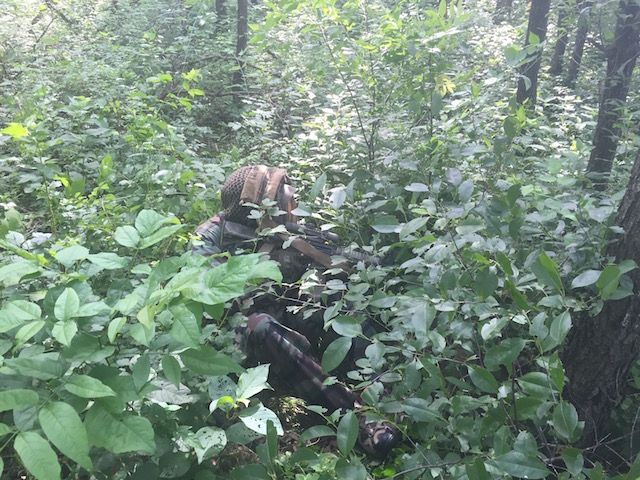
We moved just inside the treeline and Greg talked about camouflaging your position for a hide or ambush. For some quick concealment he really likes applying some vegetation to your pack (another use for MOLLE loops). That way you can plunk it down in front of you and have a bit of obscuration, while also making it easy to get to your gear without a lot of visible movement.

For a more permanent position, he favors the duck blind technique. Cut some moderately large chunks of vegetation and “plant” them just in front of you. Among other things this helps keep them from drying out, just like putting cut flowers in water (hey, the samurai studied flower arranging). He emphasized cutting vegetation from behind you rather than in front of or around your position, as well as making sure you approach the hide/ambush site from the rear rather than tramping a path right to your position.
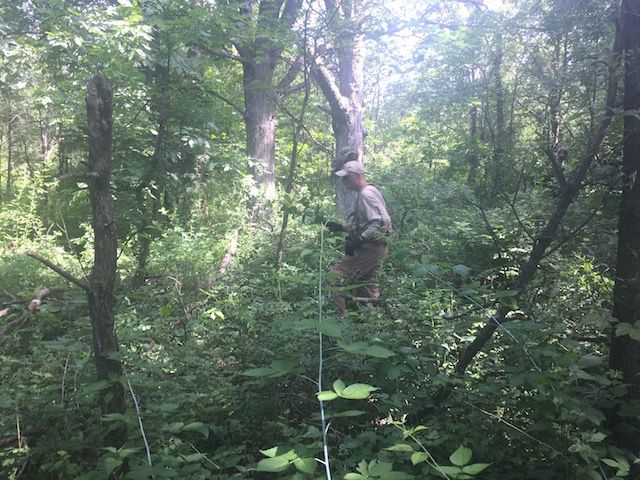
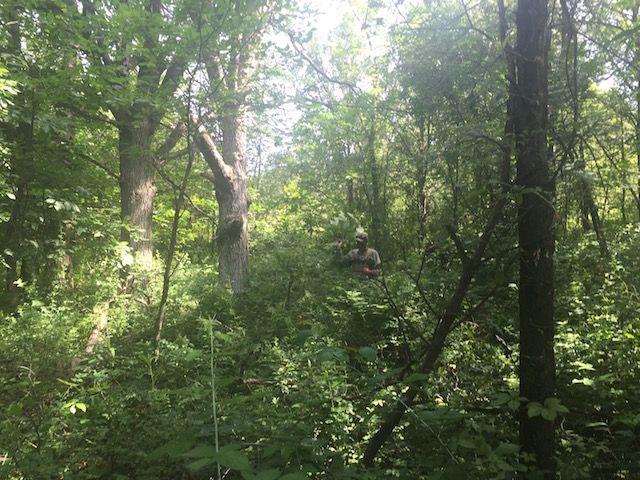
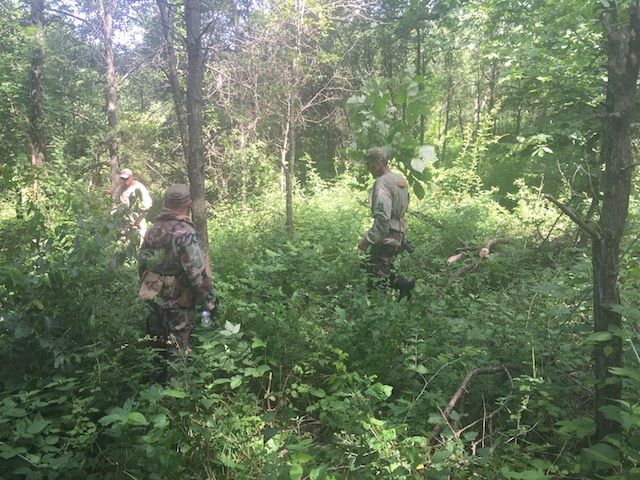
I ran into a bit of a gear limitation here. I had never found a spot I really liked for a fixed blade on my war belt, and the folder I had with me really wasn’t adequate to chopping through some of the pieces of bigger, woody vegetation that would have been good for my “duck blind”. I’ll have to remedy this before my next class.
With our hides built Greg went through the sort of things we might be looking to learn as we observe activity from our hide. The standard military acronym for this (because everything has to have an acronym) is SALUTE: Size, Activity, Location, Unit, Time, and Equipment. How big is the enemy unit? What are they doing? Can you identify what unit they are? (unit patch, or at least whether they’re regulars or irregulars) When did you observe them? What sort of gear did they have?
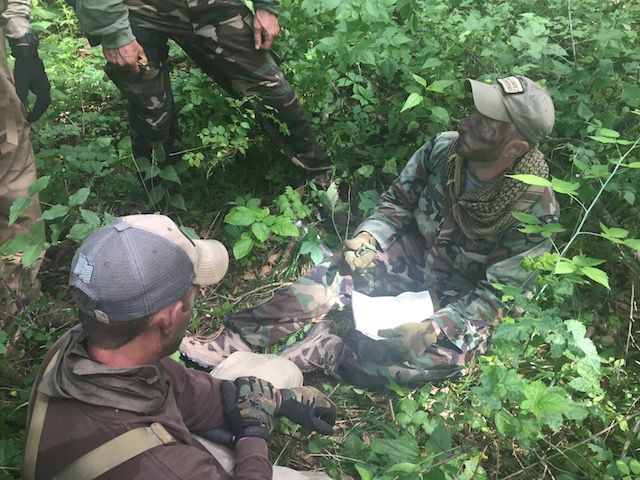
Greg broke out the map and went through some basic map reading stuff, orienting it, showing where we were, what the terrain around us was like, etc.
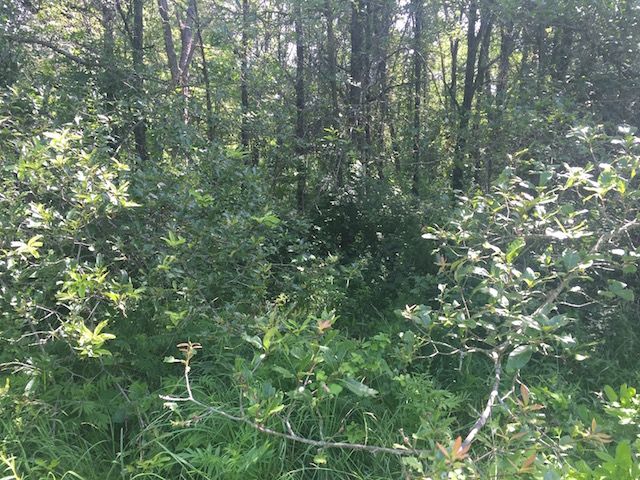

We headed out from the treeline to examine our hides, leaving one team member behind to show how they looked with someone in them. After a bit Greg swapped places with him to give him a chance to see as well. They were pretty hard to spot. One big difference between this and other patrolling classes I’ve taken in the past is just how favorable this thick, heavily vegetated terrain is to making hides. With just a little bit if effort you can be all but invisible to anyone more than a few yards away.




Abandoning our hides, we moved out into the open area and worked some more formation movement. Greg introduced the concept of the peel and we did dry drills, starting with linear peels and then moving on to lateral peels.
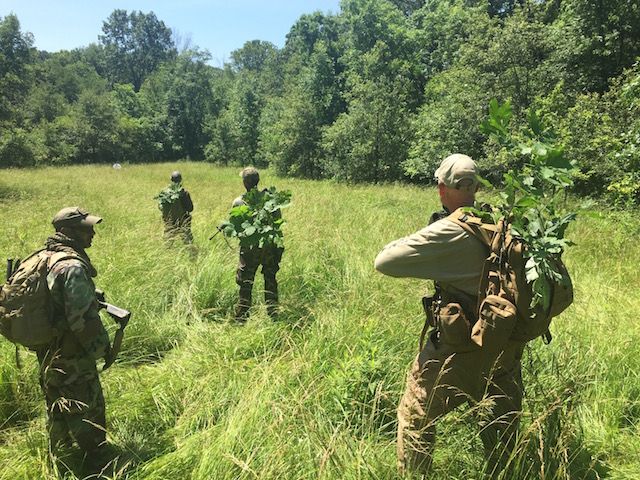
It was time to head back and Greg decided to get us out of the open area and make some use of the woods for cover. He took us across a creek that was deeply incised into a gully about 8-10 feet deep. Getting down it was a matter of sliding down the near vertical bank on your ass. Getting up the sloppy, muddy gully wall was even more difficult, but after a couple of tries we were all able to make the top. Then Greg took us up that very abrupt elevation transition between the low areas and the top of the ridge. This was complicated by some fairly thick undergrowth. I was pretty gassed when we got to the top, but if there was any consolation it was that we really did do all of the elevation in one go. Once we were done with it the walk back to the barn was nice and level.
At this point in the early afternoon it had gotten pretty hot. The forecast high for the day was above 90 with very high humidity. While the woods had provided shade, they also stilled any hint of a breeze, leaving it hot and muggy. The instructors had decided that we would have a siesta during the hottest part of the day, then pick up with more team operations late in the day, followed by some night ops. So we all enjoyed some rest and drank bottle after bottle of water to get rehydrated.
Later in the afternoon, after the heat had peaked, John put together a brief taste of the SI Defensive Knife class. He showed some of the basics defenses to attacks with both knives and longer contact weapons (bats, tire irons, etc.), as well as a nice active shooter takedown using the knife. This was just a taste of what the full 2-day class offers, but it certainly seemed to excite the interest of many of the students.
After the knife stuff the heat of the day had finally broken, and we got geared up for some more ops. We would do an exercise during the daylight that remained (quite a bit, given how late sunset was this time of year) and then go back out after dark for some night fire.

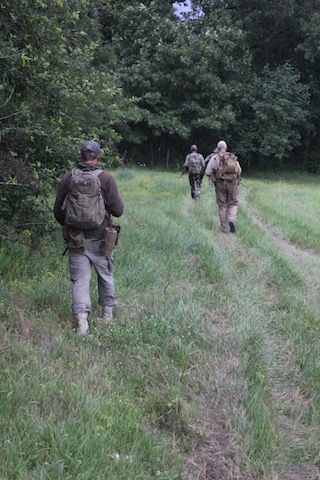

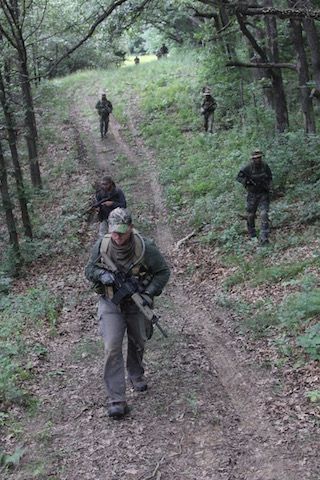
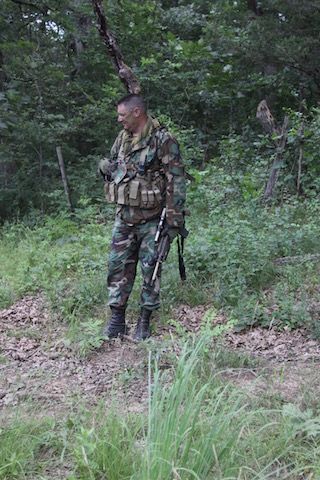
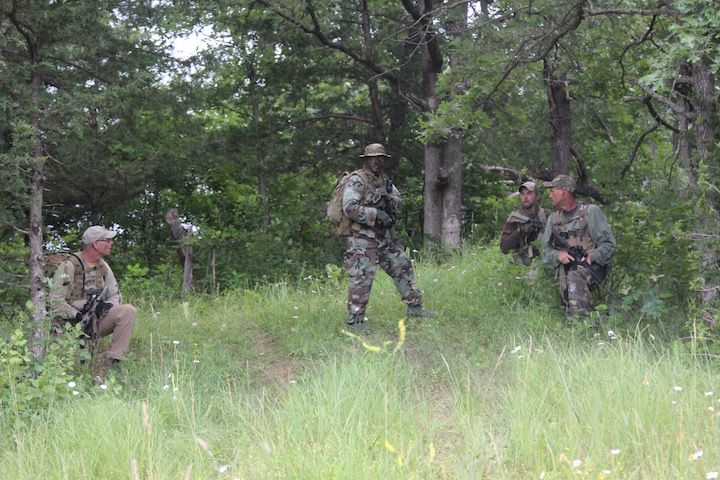


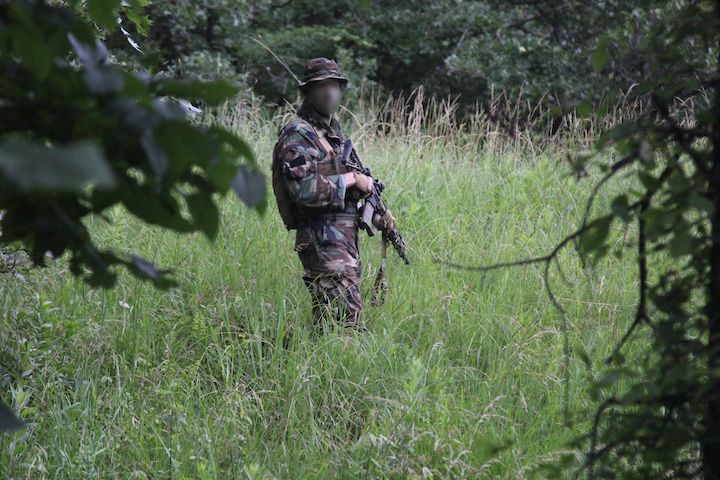

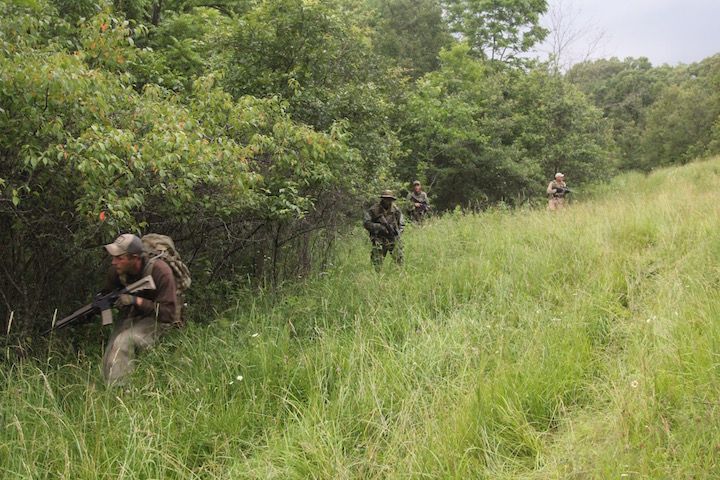
Each team was to set up a hide and then do some observation, run a patrol, and do a simulated ambush, rotating through the different roles. To get some good pictures I ditched my team to play photographer (they were good sports about it though). We headed down to the same are where our group had been during the day. The different teams broke off to their assigned hide sites and started putting together their positions.

As we were doing this, some ominous looking clouds were rolling in. Before we had a chance to finish the hides, the lightning started. Now as the saying goes, “if it ’aint ’rainin, we ’aint training.” Lightning, however, is a different matter, particularly when everyone is carrying around a long metal rod. The instructors called in the teams and we booked it back to the house and barn. As we got there the threatening weather had us almost completely surrounded.
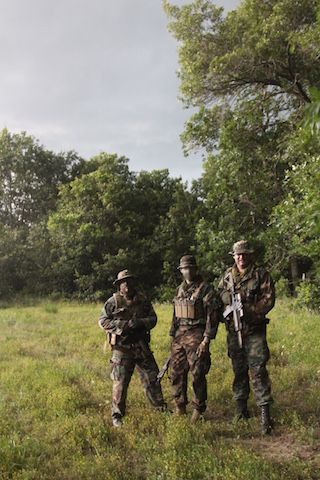



The storm broke shortly thereafter. It continued off and on for a long time, including some where it just rained hellaciously. We hung out in the barn, shooting the breeze and indulging in some libations. Since the night fire was clearly a bust (even if the rain magically stopped the cardboard targets would have dissolved at this point) one of the students broke out his PVS-14 NVG and Sua talked about NVG issues for a bit. He broke out some variously colored lightsticks to show how different colors showed up differently through NVGs (I donated one of my IR chemlights to the effort).
As it got towards 11 o’clock with no signs of stopping we broke up and the instructors and host headed back to the house. I was a bit worried about how my little backpacking tent held up under the deluge (to the point that I asked the host if I could rack out on his floor under a blanket if all my gear was wet). But when I got in I found that the only real moisture inside was what had come in with me. I was pretty impressed. Even so, I didn’t get a ton of sleep, as the wind, rain, and lightning continued until about 3am.
The next day the host found a bucket that had been left out overnight. This impromptu rain gauge had well over four inches in it.
Sunday
After a somewhat rough night’s sleep, I rolled out of bed on Sunday morning. I packed up all the gear in my tent, but left the tent standing in hopes that it would dry off a bit. After some breakfast I got geared up and ready for class.
The instructors had been planning to head over to the same property where we trained Friday for our final exercise. However, they figured that the field that had been a bit boggy in places on Friday was probably a lake at this point. So we stayed in place. When the host who owned that property came over he showed us pics of the field and it was clear the instructors made a good decision (even more striking were the pics of the pickup truck-bed deep water he drove through on the way over).
Today would be one big exercise. Each team would have to move from an insertion point, retrieve an item from a cache, build hides and conduct some observation, and conduct a mock ambush. Each event would be scheduled to take place at a pre-set time, but the order would vary for each team. The location of the insertion and ambush would vary as well (all three teams were set to retrieve from the same cache and to observe the area around the house and barn).



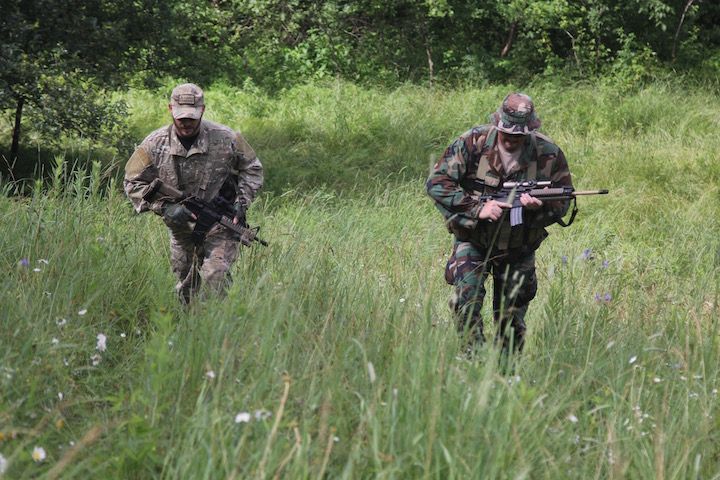
Again, I would play photographer rather than join one of the teams. While Sua briefed each team I accompanied Greg and John as they set the cache. The host warned us to stick to the high ground and not take the Gator down into the lower areas. With the ground so saturated, we wouldn’t have gotten back up. Even so, in a steep spot John and I had to jump out and Greg backed it up to get a running start to make it to the top.


I headed out and got some shots of the first two teams as they were inserted with the Gator. Then I followed the third out from the barn as they inserted on foot.

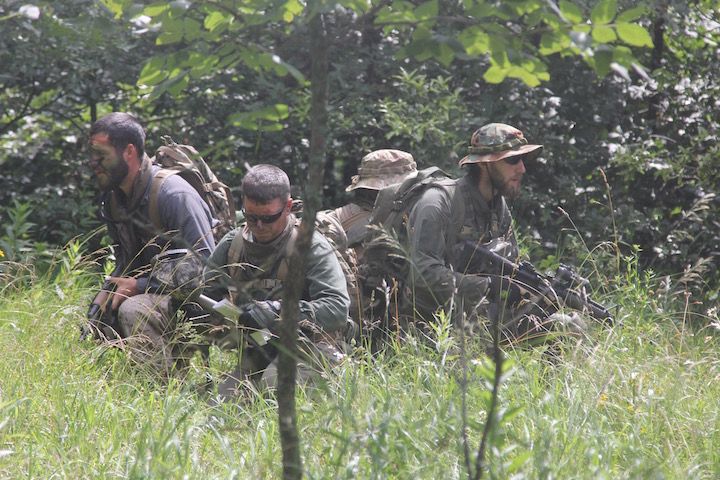
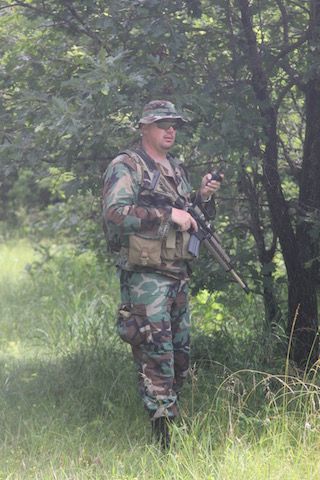
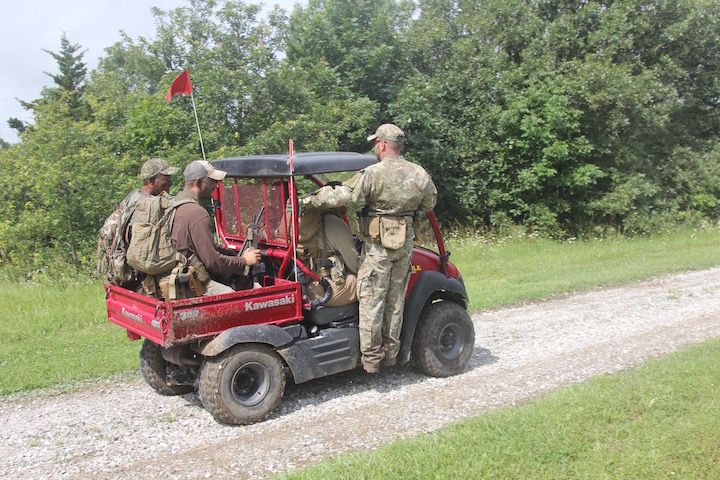
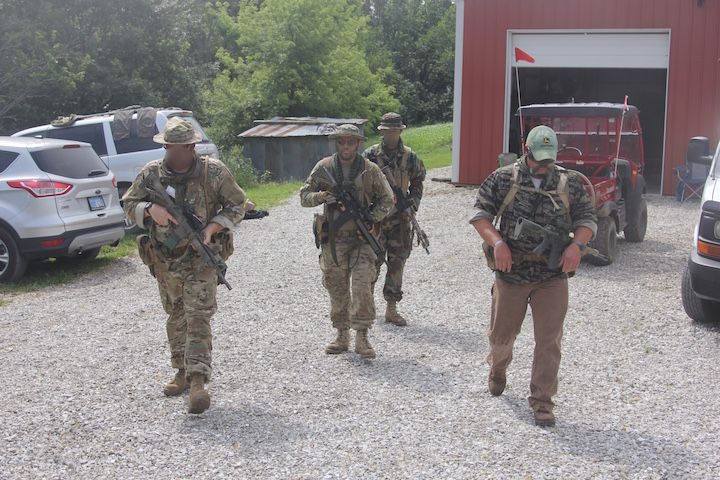
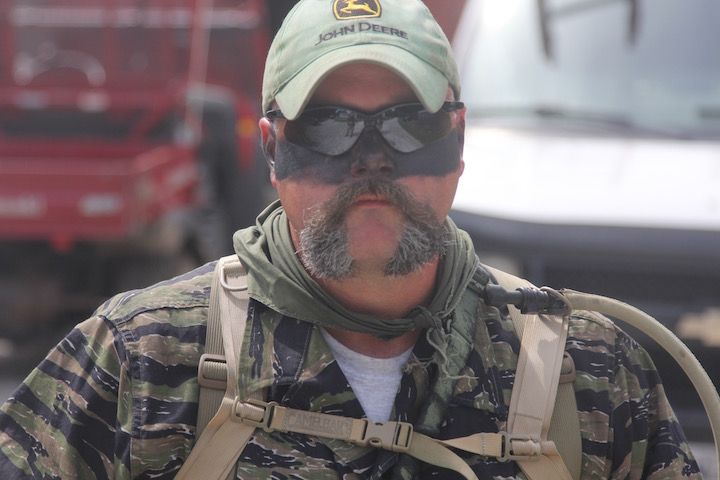
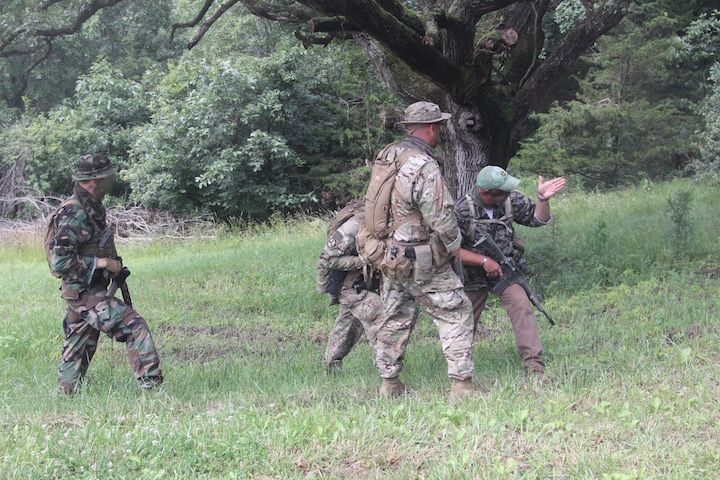

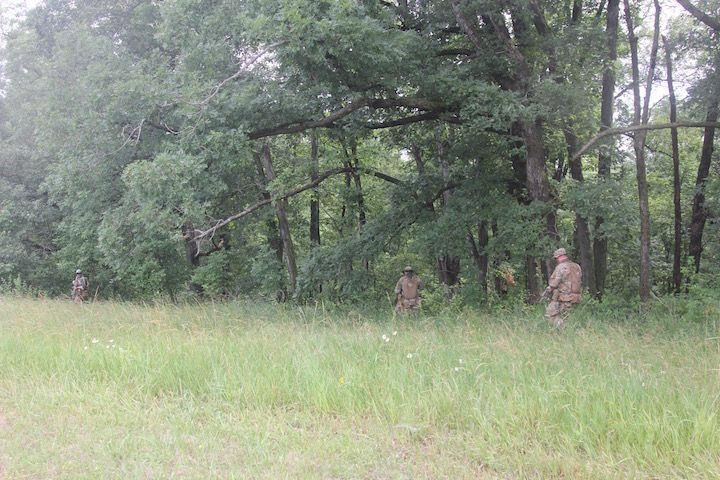
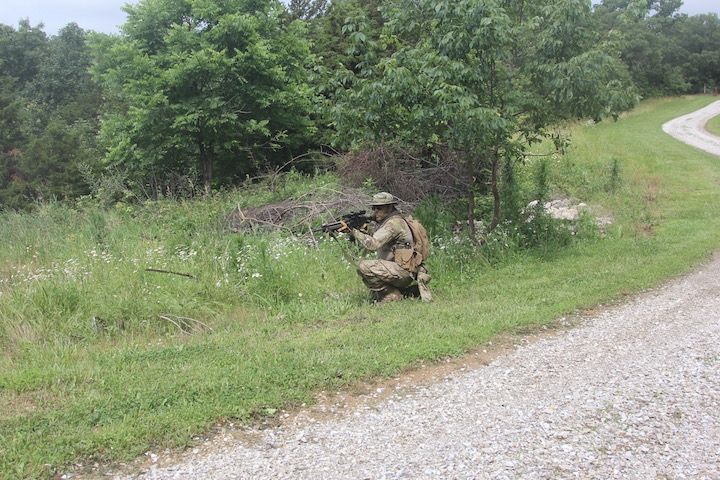
Since I’d gone with Greg and John while Sua was briefing the teams, I didn’t know their schedules or the order they were to perform the different tasks. I just knew their insertion points and that each team would have to observe the house and hit the cache before 3pm. It was up to me to find these teams and get some good pics while they were trying not to be seen.
My first catch of the day came when was able to photoambush a team as they crossed a power line cut. I’d known that two teams had inserted in the forested area between the power line and the driveway and would have to cross one or the other in order to reach their objectives. I set up where I could watch both, and it paid off.
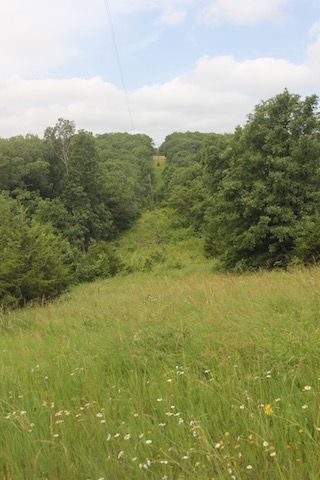
This was the start of a trend where I could hear teams moving through the heavy vegetation long before I saw them. The heavy brush makes it very hard to see someone moving back in it (and almost impossible if they’re laid up in a hide) but it’s hard to move through with any sort of speed without making a lot of noise (and to make the exercise schedule, there was no choice but to move relatively quickly). The other giveaway in some situations was moving vegetation. In this case I could see the top of a sapling moving back and forth to signal their approach as if to say, “Hi! We’re here!”.
When they reached the power line cut, they did a really great linear danger area crossing, covering effectively in both directions as they crossed one at a time. It was a thing of beauty, and the fact that they were at this level after only three days of training is a testament to both the students and instructors.
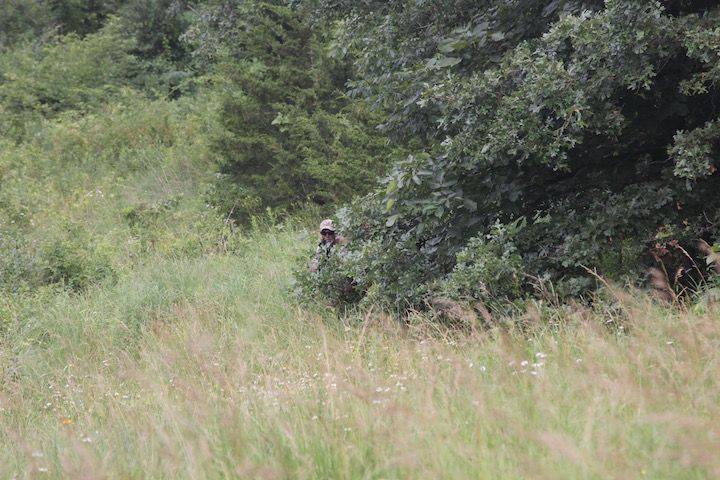
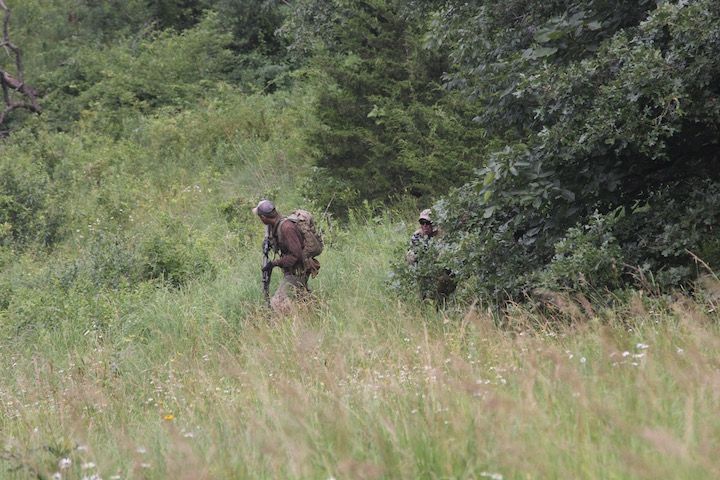
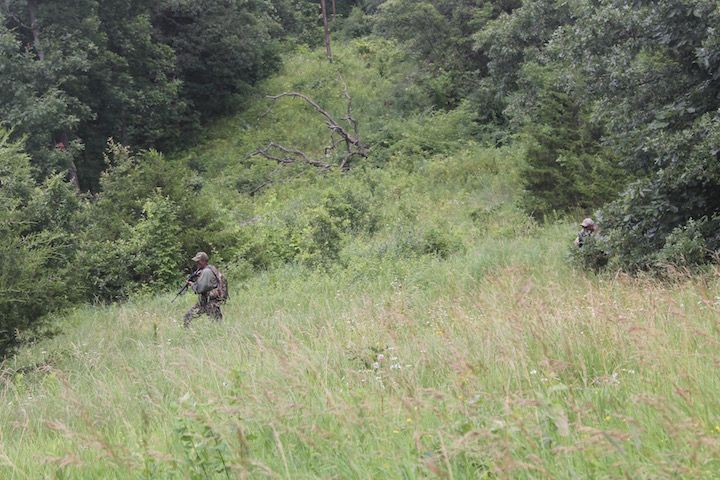

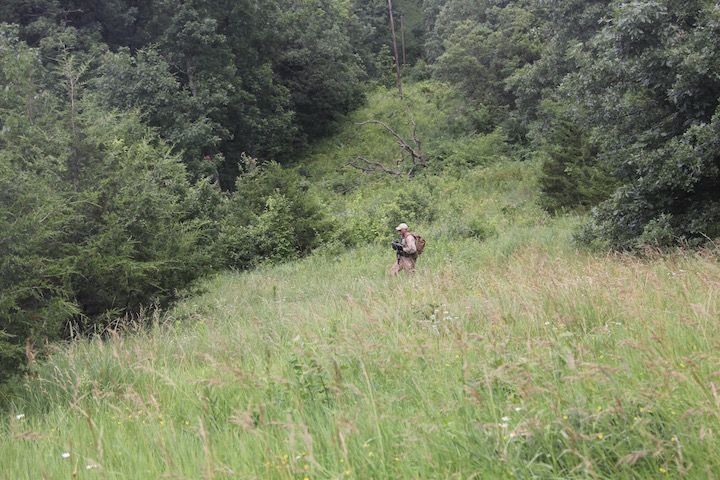
I waited around a bit to see if I would see the other team, but after a while I pulled back to the house to see if I could catch anyone setting up a hide (later I heard the second team executing an ambush over by the power line cut, so they were probably setting up on it rather than crossing it at the time).
Back at the house, I saw John’s team come moving by along the fence line at a very quick pace. Later I found out they’d overshot their objective, tried to get back cross country, and were confronted by an impassible ravine. They had to backtrack to their last known good point, which was all the way back where they inserted, then take another route from there. Despite basically tripling the distance they had to travel, they still made it to the cache at the appointed time!

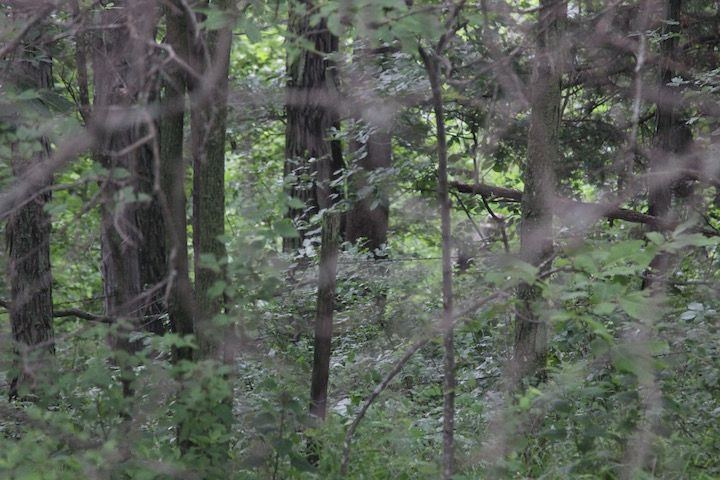
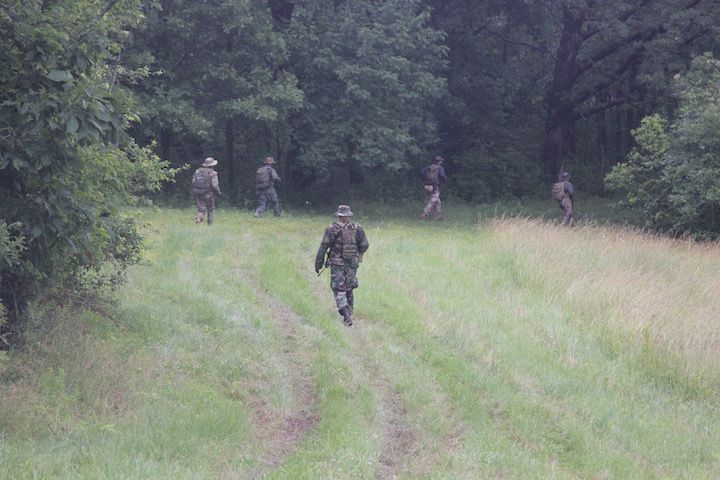

Shortly thereafter I saw Greg come walking up through an open area without any students. After watching him for a bit I figured that his team must be in the nearby treeline setting up their hides. I was able to pick up some hints of movement as they built their hides, but not much. Once they set up they were pretty much invisible from where I was up by the house. After a bit Greg moved off away from the house, so I figured his team must have withdrawn, but again I didn’t actually see any movement.


A bit later John came walking up to the house to get some water resupply for his hard charging team. While he was doing this they were in their hides doing their observation. I was on the other side of the house when they got set up, so this was a bit more of a challenge, but John’s presence and a bit of noise gave me a rough idea where half his team was (they’d split up for their observation). This time I moved right on up to see if I could get a look. I had to get within about 10 feet before I could make anything out (the shape of a boonie hat, in this case). It was pretty impressive how well they were camouflaged. Without John’s presence at the bit of noise that they made I never would have located them.
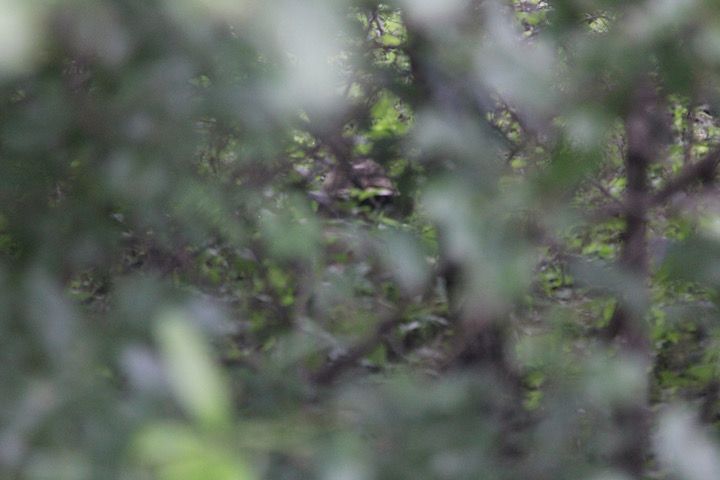
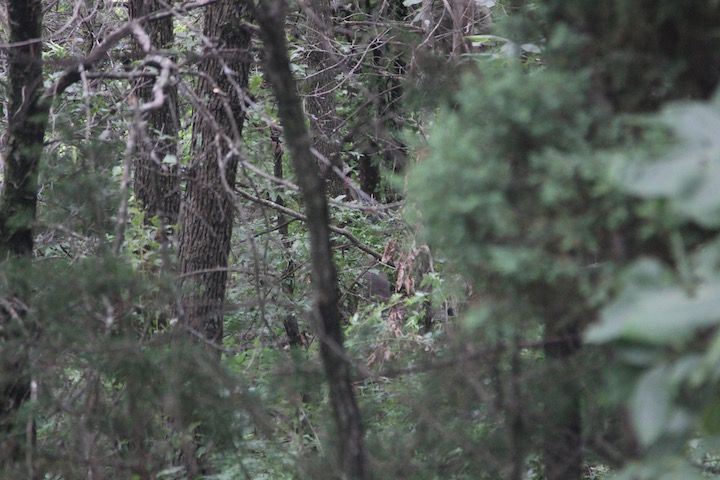
Just after I’d taken my pics, Sua’s team came buy moving along the treeline at quick pace (another team hard up against a deadline). I think Sua spotted John’s guys, but I don’t think any of his team did, despite passing within 10 feet of them.
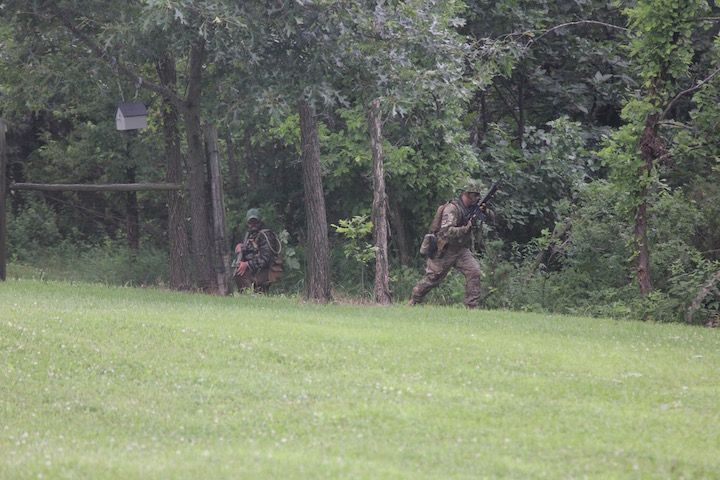
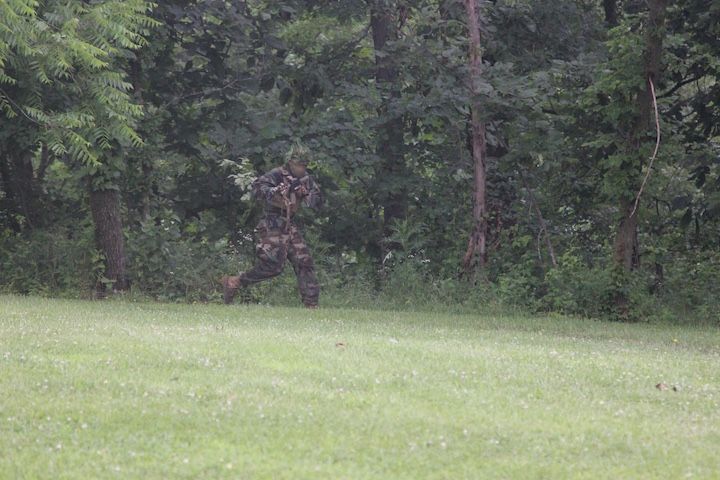
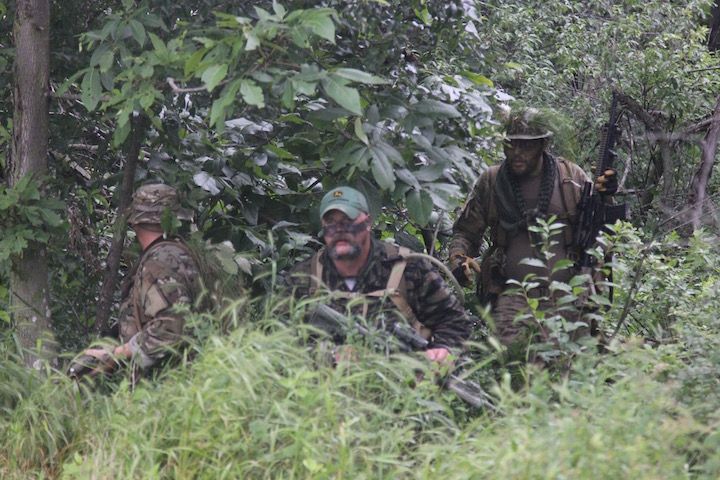

Since I knew John’s team still had to perform their ambush and that would be a good opportunity for pics, I attached myself to them for the rest of the exercise. The two halves of the team rendezvoused at the appointed time and John made all of them slam down some water. From there they headed out to the other side of the house to their ambush point.


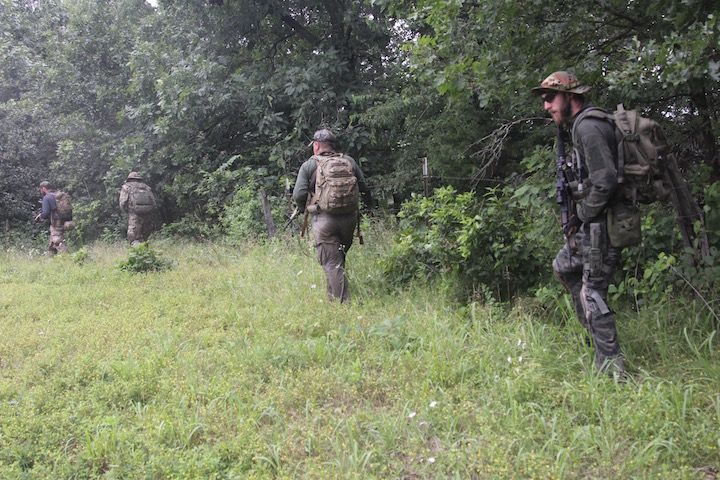
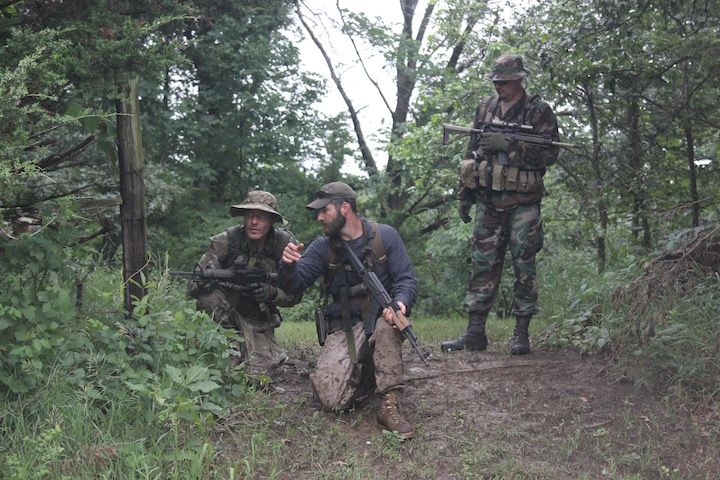
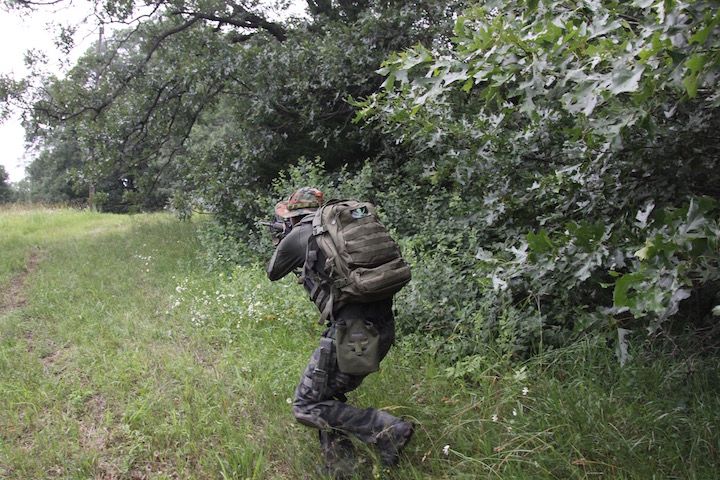


At the ambush point there was some discussion of where the best spot to set up was, then they moved into position. They were quite a bit ahead of their required time so they had plenty of time to set up. Between that and a well picked spot they were able to get really well concealed.

<p>There are four students in this picture.</p>Even after putting some time into improving their positions there was still a quite a bit of time left in the exercise. So John made them wait in their ambush positions for a good while (long enough for arms and legs to start to fall asleep). Finally he called the ambush and they commenced yelling “bang” at the notional enemy force. On the signal, they assaulted across the ambush site, then had some guys provide security while the others simulated actions on target (where in real life you’d be gathering weapons, intel, etc.). Again, it was a tremendously well executed drill after just three days of learning this stuff.



After that they withdrew from the ambush site and headed back to the house.
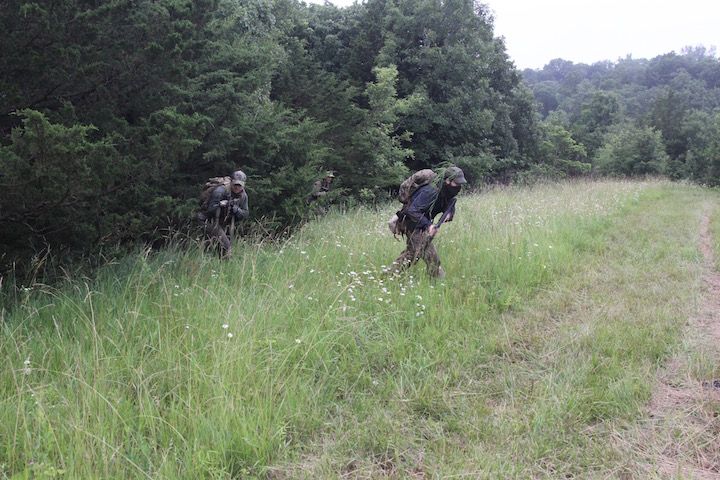
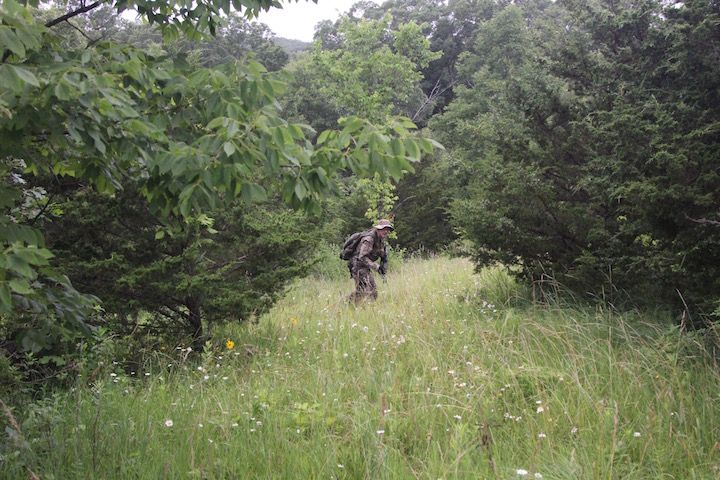

Once all the teams were back at the house we assembled for a class photo with a couple of smoke grenades in the background. Because there hadn’t been any shooting in the class since day 1, Greg and John set some targets up and let everyone do a “mad minute” and dump a couple of mags into the berm. Sua initiated the festivities with some tannerite.


After turning some money into noise we all got our gear loaded up, helped the host clean up the house and barn, and headed out.
Rather than drive the whole way home I had a hotel reservation back on I-35, about an hour and a half away. As soon as I got there I took a shower and crashed for about ten hours. I drove the rest of the way home on Monday, getting back about noon.
Conclusions
First off, this was truly a great class. Greg Nichols, John Chambers, and Sua Sponte did a great job teaching it. They imparted a hell of a lot of knowledge to the students. The final exercise really demonstrated how far the students came in just three days. As I said earlier, this really reflects well on both the students and the instructors.
The kit I brought worked pretty well. Even when playing cameraman I still wore a war belt and camelback and carried a rifle. The main lesson as far as my gear goes is the need to find a good spot for a fixed blade knife on my war belt. It would also be nice to get something in between the water-bladder only Camelback I’ve got and a full 3-day pack. There are a couple of other minor tweaks I need to make, but nothing major.
That said, one of the things the instructors emphasized is that gear is very contextually dependent. The gear you’d use running around for the woods like this is different from what you’d use working out of a vehicle, which would be different from what you’d use if you were operating without resupply for a week. There is no one best set of tactical gear, it depends on what you’re doing.
There were some changes I need to make to the non-tactical gear I bring if I come to this venue (or another with similar lodging arrangements) in the future. One thing I really wished I’d brought was a pair of sandals or flip-flops. The first thing you want to do after a long day of Rural Patrolling is to pop the boots off and let your feet breathe and dry out (and this isn’t just for the comfort factor, it’s important in keeping your feet functional over an extended class like this). In a hotel room or bunkhouse it’s easy enough to just walk around barefoot but here if I took my boots off in the barn or on the porch I was kind of stuck there unless I wanted to put them back on. I had a pair of sneakers, but that’s not the same as sandals as far as letting your feet air out.
When I was packing for the class, I thought about bringing a stove so I could cook some hot food, but I ended up deciding against it. If I had it to do over again I would have brought it. I got by on cold cut sandwiches and cereal, but it would have been nice to have some hot food for breakfast and for dinner on Saturday.
The other big lesson for non-tactical gear out of this class was to come up with a better method for organizing stuff in my car. Between rural patrolling gear, DMR gear, and camping gear I pretty much filled up my little SUV to the brim (or at least the window line). I spent a lot of time digging through it looking for stuff that I needed. Better organization would have saved me quite a bit of time.
The heat during the class was pretty brutal. Even with the siesta on Saturday afternoon and the somewhat lower temperatures on Sunday it required a lot of effort to make sure I got enough water and stayed cool enough to be functional. I did pretty well on this Friday and Saturday, but Sunday I wasn’t drinking enough water (and I was probably sweating a lot less than the guys running the exercises). I ended up paying a bit for this later. This is despite the fact that Sunday was probably the coolest of the three days.
One of the best aspects of this class was having almost everyone bunking on-site. When the host talked about his reasons for letting folks stay on site, he tended to emphasize the financial aspect of saving on a hotel bill, but as useful as that is I think it really misses the bigger picture. I could easily have afforded to stay in a hotel, and if I had I probably would have slept better. But if I had, I would have missed out on the camaraderie, fellowship, and learning that take place after the formal class day is done. Several of the students even commented that some of the best learning took place “after hours”. Classes like where everyone stays on-site, whether it be Chambers’ DMR courses in Coleman or the old Warrior Skills Camp, are truly special experiences.
